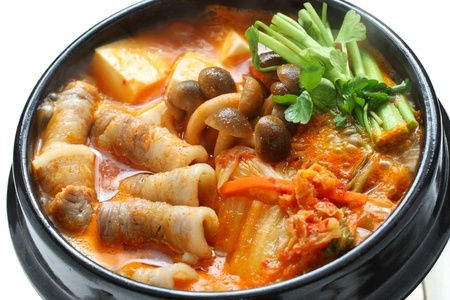
Korea is known for spectacularly interesting foods and kimchi – pickled vegetables is certainly one of them (Cheigh and Park, 1994). The reader might find alternative spellings such as kimchee or gimchi.
Kimchi is a traditional fermented vegetable side dish usually prepared from cabbage, radish, scallion or small onions, or cucumber. It is prepared by salting vegetables and fermenting at low temperatures with lactic acid bacteria [LAB] (Jung et al., 2014) such as Lactobacillus and Leuconostoc. It is notable for being seasoned as spicy and sour. Kimchi is produced commercially, but many families also make it at home using traditional preparation methods.
Other types of kimchi occur such as dongchimi which is one of the traditional Korean watery kimchis.
The preferred vegetable is cabbage known as kimchi cabbage or chinese cabbage (Brassica rapa L. ssp. pekinensis) which suggests similarities to sauerkraut but not so nutritionally! Kimchi is high in fibre and low in fat. It ‘operates’ like mustard as it’s a condiment served everywhere in Korea. It’s also offered as a side dish. Most commonly it is offered alone and plain – relaying its sour flavour or with rice. In the United States, Kimchi is served in tacos and burgers.
In Korea, a good manufacturing facility is SamJin G.F. in Naju, Korea.
Production Of Kimchi
Although many different vegetables are used in Kimchi production, the Korean baechu which is a type of Chinese cabbage (Brassica campestris L. ssp. pekinensis Rupr. and sometimes called B. rapa ssp. pekinensis) is grown specifically for this fermentation. In the USA this can be substituted with a typical Napa cabbage.
Kimchi is soaked in salt solutions up to 17% w/v for between 5 and 6 hours. It should be washed a few times with water. These salted cabbages are hung in wicker baskets to drain excess water at between 5 and 10 hours for another 6 hours.
In the urban centres of South Korea, the kimchi is either purchased from retailers or prepared in the house using kimchi refrigerators. These are small, programmable-temperature refrigerators that provide an initial 18°C fermentation period of a few days, followed by very cold refrigeration (1 to 2°C).
To increase the piquancy in flavour, other ingredients are added such as spring onion, red pepper, ginger, carrot, salted anchovy and shrimp. The red pepper is there to add a strong pungency to the product and is regarded by some Korean chefs to be essential for the flavour, others believe only the cabbage should be enough. Vegetables such as cucumber, radish, garlic and chilli also add vibrancy to flavour. This versatility in flavour creation makes it a valuable addition for product developers aiming to generate new flavour combinations.
The final salt concentration is usually between 2.3 and 2.3% w/v. A starter culture of Leuconostoc citreum is added usually up to 107 CFU/g of kimchi.
Kimchi can also be served in butter and added to stews and meat dishes, as part of patties and pancakes
Kimchi needs to ferment to generate the umami taste and so contains a variety of organic acids including lactic and acetic acid. The umami taste comes from amino acids. Vitamins, prebiotics and mannitol are also present.
The rate of fermentation is an important feature as it influences taste and flavour development during fermentation.
The temperature of fermentation impacts growth and thus ripening time (Mheen & Kwon, 1984). The cooler the home temperature the slower the fermentation which means that the rise in temperature and of pH is slower.
Aroma and Flavour
During fermentation, kimchi is allowed to develop various flavours and aromas indicative of fermentation. One study with and without fish sauce was analysed by vacuum simultaneous steam distillation−solvent extraction/gas chromatography/mass spectrometry (V-SDE/GC/MS) and GC/olfactometry. The team from Changwon Nat. University looked at odour intensities. From the outset, the addition of fish sauce did not ‘noticeably affect the aroma profile’.
Irrespective of the presence or absence of fish sauce, there were eight sulfur-containing compounds having garlic-, garlic salt-, onion-, green onion-, and cooked cabbage-like odours. There were six unknowns with garlic-, onion-, and green onion-like odours.
The most intense aroma chemicals were dimethyl trisulfide, diallyl disulfide isomers, diallyl trisulfide, methylallyl disulfide, and an unknown (garlic salt- and/or mustard-like) compound. The other aromas were 3-(methylthio)propanal (baked/boiled potato-like), (E,Z)-2,6-nonadienal (cucumber-like), phenylacetaldehyde (honeysuckle-like), linalool (floral- and/or flower-like), (E,E)-2,4-decadienal (fatty and/or sweet), 2,3-butanedione (buttery), unknown (meaty), unknown (apple sauce-like), and unknown (vitamin and/or cooked rice-like).
Dietary Fibre In Kimchi
Kimchi is a rich source of dietary fibre. These are non-digestible carbohydrates that pass largely untouched through the large intestine if gut micro-organisms were not present. They are mainly carbohydrates such as pectins, cellulose, polyfructoses, hemicelluloses and lignins that are the plant cell walls. For the gut microbiome, these polymers are important energy resources which is where the prebiotic aspect of kimichi comes from. The gut bacteria derive a great deal of metabolic benefit by turning some of the fibre into short chain fatty acids (SCFAs) as well as other metabolites. All these compounds are sources of energy not just for the gut microbes but for various organs in the human body.
SCFAs include acetate, propionate, butyrate and lactate. The human colonic epithelium metabolises butyrate whilst the liver metabolises propionate and muscles can use acetate anions. SCFAs are used in human gluconeogenesis and lipid biosynthesis. Propionate is a good precursor in gluconeogensis and attenuates lipogenesis by inhibition of fatty acid synthase (FAS) expression.
The Role Of Lactic Acid Bacteria (LAB)
Winter kimchi is prepared from November onwards. Lactic acid bacteria make up most of the microorganisms involved in fermentation.
It is reckoned a typical adult Korean consumes on average 50 to 200 g of kimchi per day and the market for the product exceeds 300 million US dollars. Clearly, any research on the condiment excites the interest of both commercial and home producer alike.
From the health perspective it has high vitamin C and vitamin A levels and offers lactobacilli for a probiotic-related diet. An interesting antifungal compound was isolated, 3,6-bis(2-methylpropyl)-2,5-piperazinedion from Lb. plantarum grown in kimchi (Yang and Chang, 2010).
Recently, a study assessed a variety of ingredients for fermentation in kimchi as potential lactic acid bacteria sources. The bacterial levels and their communities in five varying groups of raw materials were investigated using plate-counting and pyrosequencing. Lactic acid bacteria were found to be highly abundant in all the garlic samples, suggesting that garlic would be a major source of bacteria for fermentation. Lactic acid bacteria were also located in leek and ginger suggesting that they could also be potential important lactic acid bacteria sources. Lactic acid bacteria were identified in only one cabbage sample with low abundance, suggesting that this vegetable might not be a useful source.
The study showed that species in the Leuconostoc, Lactobacillus, and Weissella genera were key players in kimchi fermentation (Choi et al., 2002), but their successions during fermentation varied with the species. Another group, the Pediococcus have also been observed. All these bacteria were identified through analysis of 16S rRNA genes which characterises each species (Kim et al., 2004). It also indicates that members of the aforementioned genera may have different acid tolerance or growth competitiveness.
Can Kimchi Influence The Development Of Diseases?
Kimchi may ‘positively’ prevent certain disease states through its affect on lactic acid bacteria (LAB).
In combination, the ingredients of kimchi and the components generated by LAB might inhibit the causes of carcinogenesis especially in the gut. Lactic acid bacteria are believed to suppress the activities of various carcinogen-activating enzymes which include azoreductase, nitroreductase, 7-alpha-dehydrogenase, beta-glucosidase and beta-glucoronidase (Kwak et al., 2014). LAB also inactivates and neutralises the effects of cancer-causing chemicals.
Promoting LABs should help reduce the incidence of pathogenic bacteria and other microbes in the gut. Their presence in kimchi also improves the immune response, increases bowel movements, minimises the impact of liver cirrhosis and decreases serum cholesterol levels.
Mice studies where colon cancer has been induced with azoxymethane and dextran sulphate have revealed that treatment with kimchi extracts produced the lowest number of tumors in their large intestines. The kimchi also suppressed mucosal damage in the colon and neoplasis accompanied by a decrease in mRNA levels of various cytokines such as TNF-α (Tumor Necrosis Factor-alpha), various interferons, p53 and p21. The mRNA expression of nitric oxide synthase and cyclooxygenase-2 (COX-2) was also downregulated when compared to the control mice (Kim et al., 2014).
References
Chang, J.Y., Chang, H.C. (2010) Improvements in the quality and shelf life of kimchi by fermentation with the induced bacteriocin-producing strain, Leuconostoc citreum GJ7 as a starter. J Food Sci. 75:M103–10 (Article).
Cheigh, H.S., Park, K.Y. (1994) Biochemical, microbiological, and nutritional aspects of kimchi (Korean fermented vegetable products). Crit. Rev. Food Sci. Nutr. 34 pp. 175–203
Choi, H.J., Cheigh, C.I., Kim, S.B., Lee, J.C., Lee, D.W., Choi SW. (2002) Weissella kimchii sp. nov., a novel lactic acid bacterium from kimchi. Int. J. Syst. Evol. Microbiol. 52 pp. 507–11. .
Jung, J.Y., Lee, S.H., Jeon, C.O. (2014) Kimchi microflora: history, current status, and perspectives for industrial kimchi production. Appl. Microbiol. Biotechnol. 98 pp. 2385–93
Kim M, Chun J. (2005) Bacterial community structure in kimchi, a Korean fermented vegetable food, as revealed by 16S rRNA gene analysis. Int J Food Microbiol. 103 pp. 91–6. http://doi: 10.1016/j.ijfoodmicro.2004.11.030.
Kwak, S. H., Cho, Y. M., Noh, G. M., & Om, A. S. (2014). Cancer preventive potential of kimchi lactic acid bacteria (Weissella cibaria, Lactobacillus plantarum). Journal of Cancer Prevention, 19(4), 253.
Lee, S. H., Jung, J. Y. and Jeon, C. O. (2015), Source Tracking and Succession of Kimchi Lactic Acid Bacteria during Fermentation. J. Food Science, 80: M1871–M1877. doi: 10.1111/1750-3841.12948
Mheen, T. I., & Kwon, T. W. (1984). Effect of temperature and salt concentration on kimchi fermentation. Korean Journal of Food Science and Technology, 16(4), 443-450 (Article).
Yang, E.J., Chang, H.C. (2010) Purification of a new antifungal compound produced by Lactobacillus plantarum AF1 isolated from kimchi. Int. J. Food Microbiol. 139 (1-2) pp. 56-63


Leave a Reply